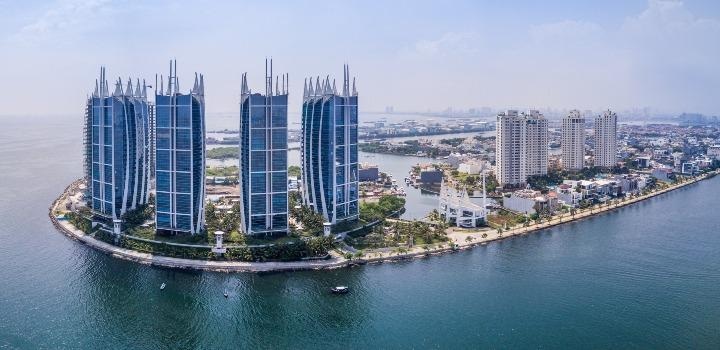Mar 9 2021
A new study by the Tyndall Centre at the University of East Anglia reports that coastal populations have been experiencing a relative sea-level rise of up to four times faster compared to the global average.
 Panorama drone picture of the Waterfront in Jakarta, Indonesia. Image Credit: University of East Anglia.
Panorama drone picture of the Waterfront in Jakarta, Indonesia. Image Credit: University of East Anglia.
Published recently in the Nature Climate Change journal, the study is the first to examine global sea-level rise together with measurements of sinking land. So far, the effect of subsidence in combination with sea-level rise has been regarded as a local problem and not a worldwide one.
However, the new study demonstrates that coastal inhabitants are experiencing an average sea-level rise ranging from 7.8 to 9.9 mm annually over the past two decades, as against a worldwide average rise of 2.6 mm per year.
The effects are much greater compared to the global numbers stated by the Intergovernmental Panel on Climate Change (IPCC).
Climate induced sea-level rise is caused by melting glaciers and thermal expansion of water due to rising global temperatures. Rapid rates of subsidence in deltas and especially cities on deltas are also human-caused, mostly due to groundwater pumping, also oil and gas extraction, and sediment resupply prevented by upstream dams, flood defences, sand extraction or mining.
Robert Nicholls, Study Lead Researcher and Professor, Chair of Climate Adaptation, University of East Anglia
Nicholls, who is also the Director of the U.K.’s Tyndall Centre for Climate Change Research, noted, “About 58 per cent of the world’s coastal population lives on deltas where land is subsiding. Less than 1 per cent of global coastal population lives where land is uplifting. We wanted to look at the big picture globally, to better understand the impact of global sea-level rise combined with measurements of sinking land.”
We found that coastal populations live with sea-level rise at three and four times the global average and that the impacts of sea-level rise being experienced today are much larger than the global numbers being reported by the Intergovernmental Panel on Climate Change (IPCC).
Robert Nicholls, Study Lead Researcher and Professor, Chair of Climate Adaptation, University of East Anglia
“Addressing human-induced subsidence is important in the short term, as it is an essential coastal adaptation to protect people and economies,” added Nicholls.
The researchers evaluated four components of relative sea-level change—climate-induced sea-level change, the impacts of glacier weight removal resulting in land uplift or sinking, predictions of subsidence in cities and river delta subsidence.
Sea-level measurements were captured with the help of satellite data. Then, the team weighted their findings by population to demonstrate their significance to people.
The Dynamic Interactive Vulnerability Assessment (DIVA) model developed for comprehending coastal management requirements was used for the overall analysis.
The researchers discovered that high rates of relative sea-level rise are more crucial in South, South East and East Asia as the area has several coastal flood plains and subsiding deltas, expanding coastal megacities, and over 70% of the coastal population in the world.
They found that across the 20th Century, the city of Tokyo underwent net subsidence of 4 m, while Jakarta, New Orleans, Bangkok and Shanghai have experienced subsidence of 2 to 3 m.
In Tokyo, Bangkok, and Shanghai, the subsidence has been arrested or considerably decreased by reduced groundwater extraction, and in other cities, there has been very little direct response to decreasing subsidence.
One of the main reasons that Jakarta, the capital city of Indonesia, is being moved to Borneo is because the city is sinking due to groundwater extraction from shallow wells.
Robert Nicholls, Study Lead Researcher and Professor, Chair of Climate Adaptation, University of East Anglia
“We hope that our analysis improves the understanding of how sea-level rise and subsidence are hand-in hand for science and coastal management policy worldwide. Jakarta might be just the beginning,” added Nicholls.
The study was carried out under the guidance of the University of East Anglia (UK) in collaboration with the Global Climate Forum, Berlin (Germany), Humboldt-University, Berlin (Germany), Bournemouth University (UK), Kiel University (Germany), Université de Toulouse (France), the University of Southampton (UK), and East China Normal University, Shanghai (China).
This study was financially supported by the EC Horizon 2020 Framework Program, EC Seventh Framework Program, and IDRCEC Seventh Framework Program.
Journal Reference:
Nicholls, R. J., et al. (2021) A global analysis of subsidence, relative sea-level change and coastal flood exposure. Nature Climate Change. doi.org/10.1038/s41558-021-00993-z.